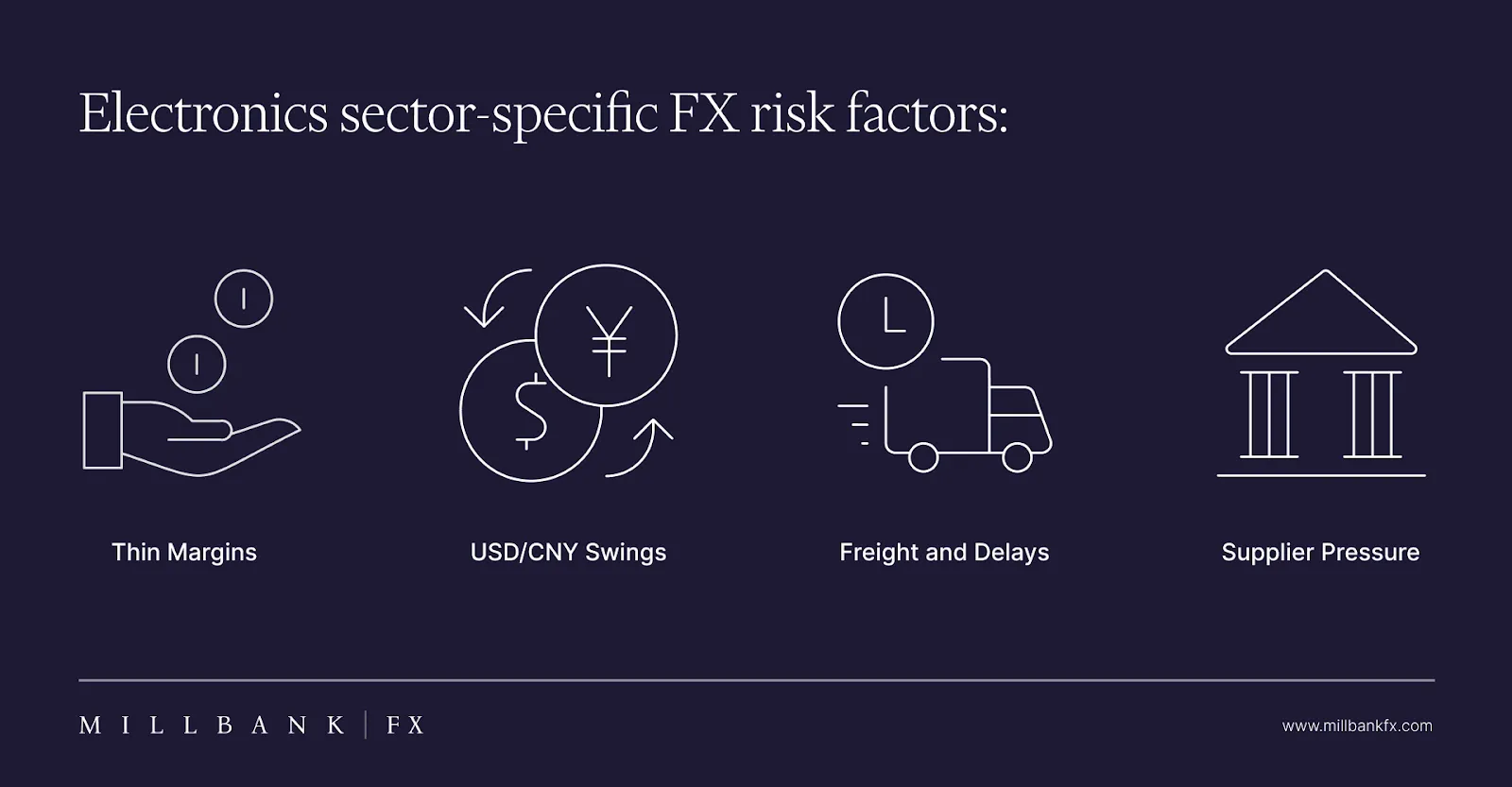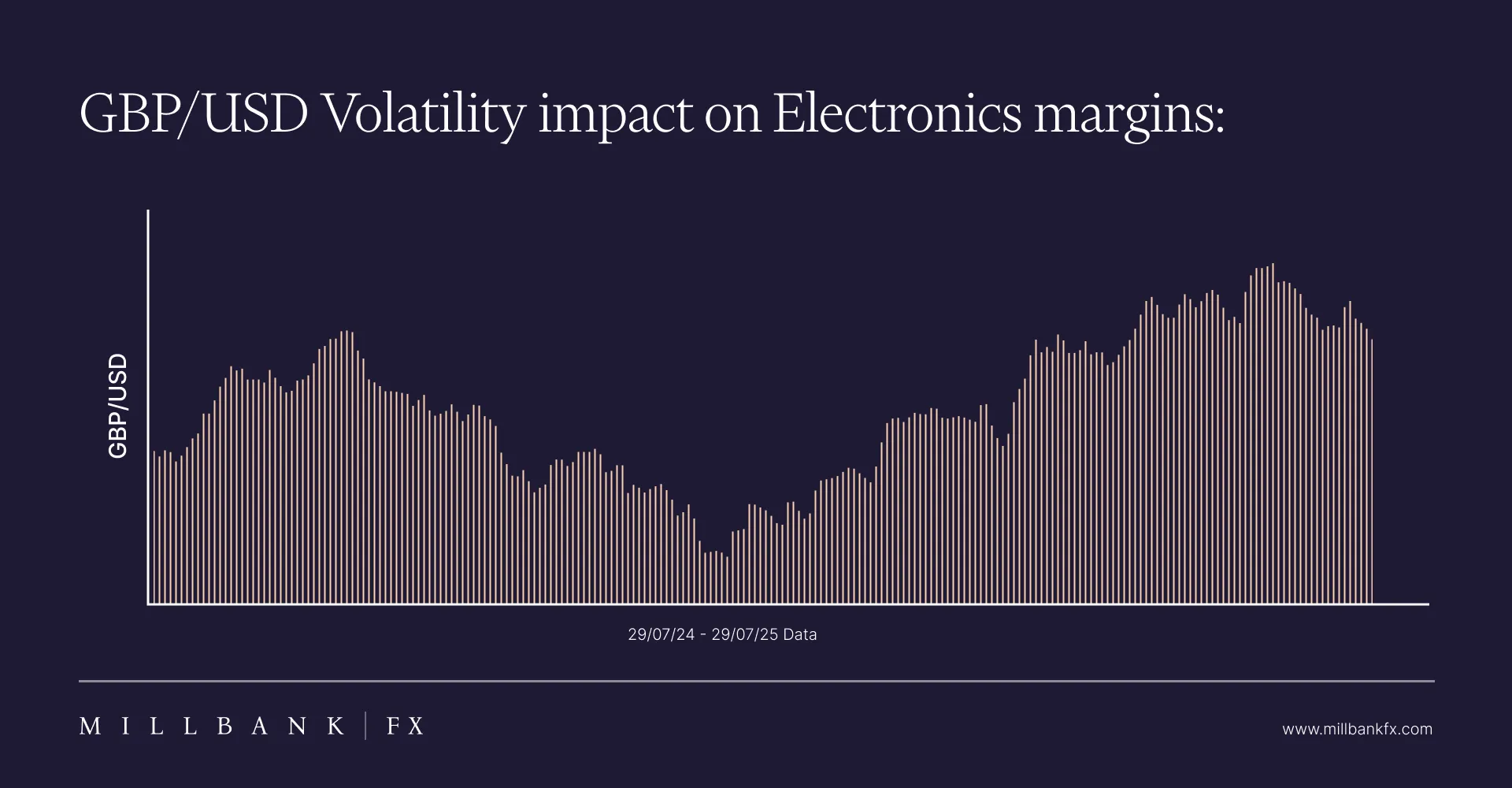Der britische Elektronikimportsektor ist geprägt von schnellen Innovationen, engen Margen und der Komplexität globaler Lieferketten. Effektives Devisenrisikomanagement (FX) ist keine Option mehr — in einer Branche, die häufig von der Volatilität des USD/CNY, wechselnden Lieferantenkonditionen und unvorhersehbaren Frachtkosten betroffen ist, ist es unerlässlich, die Wettbewerbsfähigkeit und die Gewinnspanne aufrechtzuerhalten. Dieser Leitfaden untersucht die kommerziellen Devisenrisiken, denen britische Elektronikimporteure und Finanzteams für die Beschaffung ausgesetzt sind, und skizziert umsetzbare Strategien und die Devisenlösungen von Millbank, die auf die Bedürfnisse der Branche zugeschnitten sind.
Britische Elektronikimporte: Die Devisenherausforderung
Britische Elektronikimporteure kaufen regelmäßig Komponenten und Fertigerzeugnisse in US-Dollar (USD), chinesischen Yuan (CNY) und Euro (EUR) und verkaufen sie dann in Pfund (GBP) und auf anderen europäischen Märkten. Da die Gewinnmargen oft niedrig sind — manchmal auf nur 2— 5% — können selbst bescheidene Währungsschwankungen die Gewinne erheblich schmälern oder aus einer rentablen Lieferung einen Verlust machen.
Stellen Sie sich eine Lieferung im Wert von 1,5 Millionen GBP mit einer erwarteten Nettomarge von 3% vor. Eine negative Entwicklung des GBP/USD um 2% führt zu einem Risiko von 30.000 GBP — möglicherweise der gesamten Marge. In Verbindung mit volatilen Kassakursen, Zahlungsverzögerungen und dem Risiko von Frachtverzögerungen muss das Devisenrisikomanagement proaktiv und robust sein, nicht reaktiv.
Sektorspezifische FX-Risikofaktoren
- Dünne Ränder: Der hohe Umsatz und die wettbewerbsfähigen Preise in der Elektronik lassen wenig Spielraum für Fehler. Ein ungeschütztes Devisenrisiko kann den Gewinn vollständig zunichte machen.
- USD/CNY-Schwankungen: Große Upstream-Kosten werden oft in USD oder CNY angegeben. Zolländerungen, geopolitische Spannungen und eine Änderung der Zentralbankpolitik können zu kurzfristiger und langfristiger Volatilität führen.
- Fracht und Verspätungen: Der internationale Versand von Elektronikkomponenten ist mit Verzögerungen verbunden. Im Zeitfenster zwischen Rechnung und Zahlung sorgen Wechselkursschwankungen für weitere Unvorhersehbarkeit.
- Druck des Lieferanten: Lieferverträge neu auszuhandeln oder das Auftragsvolumen vor der Währungsabrechnung zu ändern, ist möglicherweise nicht immer möglich, was das Risiko erhöht.

Strategische Tools für das Devisenrisikomanagement für Elektronikimporteure
Erfolgreiches Devisenrisikomanagement basiert auf einer Mischung aus politischer Disziplin, Marktbewusstsein und dem Einsatz geeigneter Finanzinstrumente. Zu den wichtigsten Strategien für britische Finanzmanager im Elektronikbereich gehören:
1. Währungsnettierung und natürliche Absicherung
Passen Sie eingehende und ausgehende Cashflows nach Möglichkeit in derselben Währung an. Wenn beispielsweise sowohl Lieferantenzahlungen als auch einige Kundenbelege in US-Dollar erfolgen, gleichen sich diese auf natürliche Weise aus, wodurch der Nettobetrag, der umgerechnet werden muss, reduziert wird. Dieser Ansatz trägt dazu bei, die Margen kurzfristiger Währungsschwankungen abzufedern, ohne dass zusätzliche Finanzprodukte erforderlich sind.
2. Transaktionen vor Ort
Spot-FX-Transaktionen rechnen Währungen zum heutigen Marktkurs um und eignen sich für sofortige oder unvorhersehbare Zahlungsanforderungen, wie Last-Minute-Aufladungen oder Importe in kleinen Chargen. Wenn Sie sich jedoch ausschließlich auf Spot-Zahlungen verlassen, kann dies die Kosten in die Höhe treiben, wenn sich die Marktzinsen während der Fakturierungszyklen der Lieferanten stark ändern.
3. Termingeschäfte
Termingeschäfte ermöglichen es Importeuren, sich einen Terminkurs für ein bestimmtes Währungspaar zu sichern, der zu einem späteren Zeitpunkt abgewickelt werden soll, und bieten so Planungssicherheit und Margenschutz. Termingeschäfte sind verbindliche Derivate und können Sicherheiten erfordern, wenn sich die Zinssätze gegen Sie entwickeln. Wir empfehlen dies in der Regel für Bestellungen mit festgeschriebenen Mengen und bekannten Abrechnungsterminen — entsprechend den Versandplänen oder saisonalen Auffüllzyklen.
4. Währungsoptionen
Optionen bieten das Recht, aber nicht die Verpflichtung, Währungen zu einem voreingestellten Kurs umzutauschen. Optionen können zwar Flexibilität bieten, wenn sich die Märkte günstig oder unvorhersehbar entwickeln (z. B. neue Tarifrisiken), doch sind sie in der Regel teurer und aufgrund der Komplexität der Prämien im Voraus für KMU oft weniger geeignet.
5. Flexible Zahlungslösungen
Lösungen wie virtuelle Geldbörsen und Konten mit mehreren Währungen helfen dabei, ein- und ausgehende Zahlungen zu rationalisieren, sodass kostspielige Ad-hoc-Umrechnungen vermieden werden und die Lieferantenbeziehungen verbessert werden, indem Zahlungen in der von ihnen bevorzugten Währung ermöglicht werden.

Beispiel-Fallstudie: Devisenmanagement für einen britischen Elektronikimporteur
XYZ Components, ein mittelgroßer britischer Importeur, sah sich nach einer Verschiebung des USD/GBP-Wechselkurses im ersten Quartal 2024 mit anhaltenden Margenschwankungen konfrontiert. Durch die Umsetzung einer definierten Devisenpolitik, bei der Termingeschäfte zur Sicherung der Zinssätze für ihre größten USD-Lieferungen und Währungsnettierungen für kleinere Zuflüsse verwendet wurden, verringerte das Unternehmen die jährliche Volatilität seiner Devisenkosten um über 40% Durch vorhersehbare Zahlungszyklen verbesserte sich auch die Verhandlungsmacht der Lieferanten, wodurch die Stabilität der Lieferkette und die Wettbewerbsfähigkeit auf dem Markt von XYZ verbessert wurden.
Aufbau einer praktischen Devisenpolitik
Führungskräfte im Finanzbereich sollten eine klare Devisenrisikomanagementpolitik dokumentieren, einschließlich:
- Regelmäßige Prognose des Fremdwährungsrisikos (nach Währung und Zeithorizont)
- Definition der Instrumente und Strategien, die für wichtige Rechnungsarten oder Lieferantenbedingungen verwendet werden sollen
- Schwellenwerte für die Verwendung von Forwards im Vergleich zu Spot- oder Optionskontrakten (z. B. sind Kontrakte über 50.000 GBP oder mit einer Vorlaufzeit von über 3 Monaten möglicherweise besser für Forwards geeignet)
- Regelmäßige Überprüfung und Stresstests anhand historischer Wechselkursbewegungen
Millbank FX: Branchenexpertise und Plattformvorteile
Wir sind darauf spezialisiert, britische Elektronikimporteure zu unterstützen, die unter Margendruck stehen und häufig USD/CNY-Risiken ausgesetzt sind. Unsere Dienstleistungen umfassen:
- Persönlicher Support durch erfahrene Devisenhändler — kein Vertrauen in automatisierte, unpersönliche Systeme
- Konkurrenzfähige Tarife mit transparenter Preisgestaltung im Voraus für eine genaue Kalkulation und Angebotserstellung
- Effizientes Onboarding und Compliance, maßgeschneidert für elektronische Geräte, sodass Sie Terminkurse sichern und Transaktionen innerhalb weniger Stunden abwickeln können
- Flexible Abrechnungsfenster und Zahlungsbedingungen, die auf die Lieferzyklen von Elektronikgeräten abgestimmt sind
Am wichtigsten ist, dass wir der Margensicherheit Priorität einräumen, indem wir Ihnen bei der Auswahl der am besten geeigneten Risikomanagementinstrumente helfen und Sie niemals zu ungeeigneten oder teuren Lösungen drängen.
Typische Fehler im Elektronik-FX-Management
- Verzögerung von Devisenentscheidungen: Wenn Sie auf die Fälligkeitsdaten der Rechnungen warten, ist es nicht mehr möglich, Terminkurse abzusichern und sich vor Margenerosion zu schützen.
- Schlechte Sichtbarkeit bei Belichtung: Wenn Umfang oder Zeitpunkt von Währungszahlungen unterschätzt werden, werden Gelegenheiten zur natürlichen Absicherung verpasst.
- Zu hohe Ausgaben für komplexe Produkte: Optionen und komplexe Derivate mögen verlockend sein, aber ihre Kosten eignen sich selten für Unternehmen, die in großem Umfang mit wiederholten Engagements operieren.
- Vernachlässigung des Lieferantendialogs: Wenn Sie mit Lieferanten zusammenarbeiten, um Zahlungen in alternativen Währungen zu akzeptieren oder Rechnungen zu staffeln, kann das Risiko einseitiger Risiken erheblich reduziert werden.
Nächste Schritte: Stärken Sie Ihr Elektronikgeschäft gegen Wechselkursschwankungen
Auf dem aktuellen Weltmarkt ist eine disziplinierte Devisenstrategie von grundlegender Bedeutung für ein profitables Wachstum im britischen Elektronikimportsektor. Mit der richtigen Mischung aus Währungsnetting, Terminkontrakten und fachkundiger Unterstützung können Sie die Marge Ihres Unternehmens untermauern, unvorhersehbare Kosten kontrollieren und sich einen Wettbewerbsvorteil sichern, unabhängig davon, wie sich der Dollar, der Yuan oder die Schifffahrtswege entwickeln.




